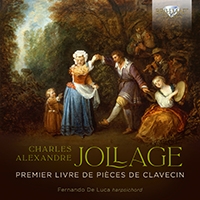Košík
Váš košík je momentálne prázdny.
Jollage: Premier livre de Pièces de Clavecin
12,00 €
Formát:
CD
Dostupnosť:
7-14 dní
Katalógové číslo:
96773
EAN kód:
5028421967738
Autori:
Charles-Alexandre Jollage
Interpreti:
Fernando De Luca
Vydavateľ:
BRILLIANT CLASSICS
Zoznam skladieb
Pièces in A Major and Minor, Suite I1 I. Courante
2 II. La cheverny – Rondeau
3 III. Le postillon – Rondeau
4 IV. Seconde partie – Mineur
5 V. Les tendresses mutuelles
6 VI. Premier menuet – 2e Menuet – 3e Menuet
7 VII. La naïve – Rondeau
8 VIII. L’Italienne
9 IX. La marais
Pièces in G Major and Minor, Suite II
10 I. La bonne amie – Rondeau
11 II. L’Obstinée
12 III. La résolue – Rondeau
13 IV. L’Agitée – La tranquille – Rondeau
14 V. Premier tambourin – 2e Tambourin – 3e Tambourin
15 VI. Gigue
16 VII. Les caquets
17 VIII. L’Utile
Popis
A world-premiere recording of elegant, courtly French harpsichord suites by a forgotten name of the early 18th century. The early life and formation of Charles-Alexandre Jollage is shrouded in obscurity. By the time he enters the historical record in the 1720s, he had become organist for the King of Poland, Stanislas Leszcznski, at that time exiled to France and settled at the castle of Chambord in the Loire region of France. In 1733 Stanislas left Chambord for Warsaw where he claimed the throne of Poland; meanwhile Jollage seems to have settled in Paris, where his only known set of work was published in 1738, and dedicated to the Marquise of Clermont d’Amboise. After that point, it has been established with greater certainty that he remained in Paris as an organist, and died there in 1761. This ‘First Book’ of Jollage’s harpsichord works was never followed by a second, but the two suites therein have rewarded the investigation of Fernando De Luca, who has already revived the little-known harpsichord music of Christoph Graupner (96131) and Christophe Moyreau (96285) for Brilliant Classics. Jollage’s refined and elegant idiom reflects the predominant taste in France during the first half of the 18th century, enlivened throughout with touches of originality. Take, for example, the penultimate piece of the First Suite: L’italienne, which is written in an entirely contemporary style perhaps emulating Domenico Scarlatti and even resembling the sonatas of Haydn. In his booklet essay, Fernando De Luca makes a pertinent comparison between Jollage and the contemporary master Watteau. ‘By combining dance, music and painting, while suspending time and movement, Watteau captures a snapshot of human life… He combines lightness and tragedy to capture a fleeting moment. Jollage draws his creative lifeblood from the same source, while retaining all the characteristics of harpsichord music of his period.’ Prihlásenie
Newsletter



